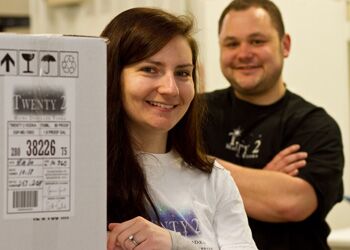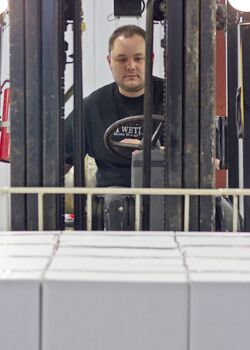In good spirits | A Houlton couple's vodka distilling startup wins international accolades
When Scott Galbiati says he devised a plan to start a vodka company while he was a college student, it’s easy to assume the New Jersey native experienced a 4 a.m. eureka moment after a long night of partying. But it was a class assignment to write a business plan during his senior year at Rensselaer Polytechnic Institute in New York that led to the formation of The Northern Maine Distilling Co., a Houlton microdistillery that’s now producing award-winning vodka.
“I guess the only thing we ended up using from that very first draft is that we’re still making vodka,” says Galbiati, now 27. He runs the company with his wife, Jessica Jewell, 28, who he met at RPI and, as she puts it, “dragged him back” to her native Houlton.
Surely the couple didn’t anticipate back in 2004 that their class project would lead to a gold medal at this year’s San Francisco World Spirits Competition in March, with a product that bested big-name brands including Stolichnaya and Smirnoff. The couple’s Twenty 2 Micro Distilled Vodka also won a bronze medal in December of 2009 at the World Spirits Competition in Geneva, Switzerland, just three months after it went on the market.
Galbiati and Jewell incorporated the company in 2006, after moving to Aroostook County and quitting full-time jobs, Galbiati as a marketing coordinator for an Oxford County credit union and Jewell as an engineer at the NewPage paper mill in Rumford. “Having a chemical engineer on board is totally key to good-quality vodka,” Galbiati says of his wife. The company also includes Jewell’s sister, who serves as director of production.
But despite being surrounded by potato fields, and Jewell’s family history of potato farming, Twenty 2 vodka is -- gasp -- grain based. Spuds were part of the original business plan, but the couple discovered that corn, which they source from New England, delivers better yield and proves a more forgiving raw material.
Customers don’t seem to mind. Twenty 2 vodka is now available in 114 agency stores and 50 bars and restaurants in Maine, and Galbiati and Jewell have sold nearly 7,000 bottles since 2006. Below is an edited transcript of the couple’s recent conversation with Mainebiz:
Mainebiz: What made you want to start a vodka distillery?
Galbiati: The overall plan began in college. We know our number one commitment is to make sure that we can safely generate a profit to operate tomorrow. That first peek into the business plan, that first draft -- which over the course of two years was probably rewritten 25 times, we really treated it as a living document -- really gave us the knowledge to let us know hey, this is something we can do.
At that time, the market, especially for vodka and high-end spirits, was skyrocketing. We couldn’t make a vodka that was too expensive. There was one brand out there, called Diva Vodka, which was going for $1,500 a bottle. It was getting to that point where it was becoming almost ridiculous, but there were a lot of people making money.
The market’s most certainly changed since, but it doesn’t mean it’s not a money-making venture by any means. When the economy’s down, people drink more, when the economy’s up, people drink better.
Why vodka?
Galbiati: We can more easily move vodka than we could if we had a really fantastic but very distinct bourbon. Bourbon’s great and there’s a lot of bourbon fans out there, but I don’t know if people are ready to make that jump. I think a lot of people, especially in our demographic in our industry right now -- we consider our demographic to be the Millennials, the 21- to 30-year-olds -- are making that transition away from beer. Not because beer is bad, but because their education is increasing. Five or 10 years ago, people were making the transition out of bad beer into products like Sam Adams or the microbrews. People are becoming more educated and vodka is that natural next step. We needed to pick something where we knew we could make XYZ cases and sell XYZ cases, instead of praying to convert XYZ people into trying something that they had no previous impression of or desire to try.
Selling something that is supposed to be neutral -- no odor, no taste, no color, no flavor -- is really is whatever you turn it into.
Why did you decide against a potato-based vodka?
Galbiati: It wasn’t giving us the final product quality that we wanted, and by quality we mean neutrality. What we were getting were results similar to Cold River. They’ve won lots of awards, no question -- I think best domestic vodka in 2008, which I’d do backflips for -- but we didn’t think business-wise that there was room out there for two people like that. Our cost per bottle would have been significantly more as well.
We really had to sit down and make a business decision. Yes, we’re from The County: How important is it that we do vodka from potatoes today, instead of looking at long-term viability, figuring out how to establish a cash flow and then getting back into potatoes when we can afford to experiment? That’s today’s plan.
Tell us about the distilling process.
Galbiati: The equipment we designed ourselves. The kettles are stainless steel manufactured drums with a coil on the inside that we had built in Lincoln. Our distilling apparatuses, which collect the vapors and condense them back down into the ethanol molecule, were built in Washington state. The whole setup is 50 gallons, but really we charge it with about 30. Fifty is an easy number to spit out and wrap your head around. But really we’re really putting out only about 30 gallons of product when we do our distillation.
We collect it in even smaller quantities, in a two-gallon stainless steel pail. Why that’s significant is distillation is all about what you want and what you don’t want. What you don’t want is what comes out at the very beginning and the very end, we call those the heads and the tails. What you do want is the heart, and the heart is that ethanol molecule that’s really going to make that perfect, neutral vodka.
Jewell: It’s very hard to hide a mistake in two gallons.
Galbiati: We dilute it back down to your 80 proof, blending in true northern Maine water, which we treat with a reverse osmosis to remove all the solids so you just have that H2O molecule. Then we put in it our cooler, we chill it, then run it through our activated charcoal filter, sometimes up to 10 times.
Where did the name Twenty 2 Micro Distilled Vodka come from?
Galbiati: We picked it because it’s intriguing and interpretable. So the official answer is there’s no official answer. People ask us all the time why and usually I reply with, ‘I’m glad you asked,’ because it starts a conversation about the business. We wanted to pick something that had broad appeal to anyone anywhere.
Jewell: We’ve had people contact us and say I’m part of a fraternity and that was always our secret number, and this is just the coolest thing, a vodka with our number on it.
Galbiati: It was a 100% shot in the dark. We’ve really discovered that it’s working in our favor. If your phone number has two digits in it next to each other that are 22 and you look at our brand on the shelf, that familiarity can get a second look. So we’re not expecting people to drop their groceries and say, “Holy cow that’s my phone number!” but it might get us a second look and they might pick us out over Absolut.
How do you set your brand apart other than the name?
Galbiati: We are the only true micro-distilled vodka out there. We handwrite the batch and bottle number on the front of each label, which falls 100% on Jess, but it has gotten us a lot of attention and people notice it. There are other brands out there that do it, it’s not groundbreaking by any means, but I think we’re the first to put it out there on the front label and not use a code. People have made buying decisions based on the fact that their favorite number is the batch, or it’s a birthday or an anniversary.
That’s helping people get an idea of the scale that we’re operating on, which really translates to quality.
Jewell: We have our signatures on the back of every bottle, and the batch and bottle numbers are put on there by hand. There’s an actual person who does that. It creates a connection with the people who are looking for something a little bit different than a big-name brand that they can’t find anywhere else.
How much does your vodka retail for?
Galbiati: The cost is $26.99 for a 750-millileter bottle. That’s the only size we offer right now and we only offer one flavor. Dealing with many accounts, products, bottles, whatever, it’s easy to get distracted. Going with one product and straight vodka and knowing we’re good at it is the reason we’ve stuck with that one offering.
Do most of your sales come from grocery stores or bars and restaurants?
Galbiati: The majority is going through the agency stores. It’s easier for them to take a new brand under their wing, order a bottle or two, put it on the shelves and see if it moves, instead of being committed to making 25 servings out of a bottle. When it picks up in availability in stores in a certain region, it hits the bars next. We’re pretty popular in the Old Port, especially being a Maine-made vodka that’s $7 cheaper than the other Maine-made vodka. But also that neutrality makes it mix better, so there’s more things you can do with it and that’s lending a hand into getting us into more bars and restaurants as well.
Our strategy has been getting it everywhere and then putting 110% into broadcasting that it’s available.
I see you have a Facebook page. Has that been part of the outreach?
Galbiati: Absolutely. Our fan response on Facebook has been fabulous. Compared to other small distilleries out there, we trump them by at least a thousand fans, no joke. Right now we have 2,300 fans. Contests and giveaways have been a huge component as well.
Jewell: One of the reasons our Facebook page works so well for us is fan interaction. People aren’t afraid to post stuff on our wall, they’re willing to get involved, which I think helps our credibility, that we’re having input from people other than the two of us.
How is your company structured?
Galbiati: We have 18 shareholders and we set up a subchapter S corporation. We took our final business plan -- which ended up to be about 75 pages not including financial forecasts -- to the lawyers and revised it down. We added a subscription agreement and all the legal requirements and disclosures for officially accepting money. It took 19 months of traveling. Eight of our shareholders are in New Jersey, the rest are in Maine and one is in Connecticut. I pretty much pitched the idea to whoever would hear me -- I think we passed out about 120 plans, printed out 4,000 pages. I put 39,000 miles on my Jeep last year.
We definitely have some family, but by no means do they make up the majority of the dollars of the shareholders. I was putting my hand out there, but with a business plan in it saying, “This is an opportunity,” not, “I am your nephew.”
When do you think you’ll be profitable?
Galbiati: It could be, easily, middle of summer. We have broker representation that we’ve signed on with, we’ve been authorized in all of the Hannaford stores, which was a gigantic step for us. They’ll preach Maine-made up and down the street, but they really need you to prove to them that you’re a serious contender. They’re not going to order half a case per store and then have you fall off the face of the Earth the next day because you weren’t watching your cash flow.
Jackie Farwell, Mainebiz senior writer, can be reached at jfarwell@mainebiz.biz.













Comments